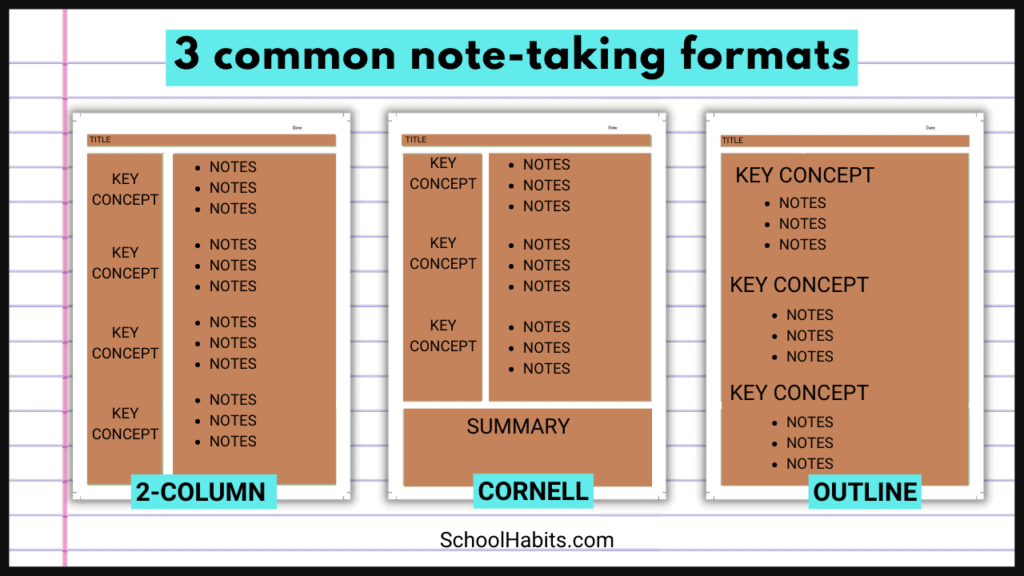
By Katie Azevedo, M.Ed.
This post teaches you how to take notes from a video. There are various scenarios when you’ll have to take notes from a video, especially for online classes. The following best practices apply to students in middle school, high school, college and beyond.
How to take notes from a video
Taking notes from a video is similar, in ways, to taking notes from a textbook – but there are differences too. Here are the best strategies for taking notes from a textbook, if that’s what you’re looking for.
I have organized this post into three categories for easy navigation. All three categories are important:
- Before you take notes from a video: Pre-note planning (3 tips)
- Taking notes while watching the video (13 tips)
- How to take notes from a video – at the next level (3 tips)
Before you take notes from a video: Pre-note planning (3 tips)
Taking notes from videos requires a bit of pre-note planning. You might already have tips #1 and #2 figured out, but if not, take the time to do so now.
1. Pick your location.
Where will you take and store your notes? You basically have three choices:
- Paper (notebook)
- Digital notes in Google Docs or Word
- Digital notes that you hand-write with a stylus or Apple Pencil
There are pros and cons to each of the above. I consistently suggest students take paper notes (option 1) or handwritten digital notes (option 3). I understand that for many, typed notes are faster. But speed is not the goal here: comprehension is.
2. Choose your note-taking format.
There are three primary note-taking formats. They apply whether taking notes from a video, textbook, novel, slideshow or lecture class. They are:
- Two-column notes
- The outline method
- Cornell notes
I explain each of the formats here, as well as the reason why I generally recommend the two-column and outline methods over Cornell notes. However, for taking notes from a video, I suggest the outline method.

3. Preview the video.
Just as you would flip through a textbook chapter before taking notes on it (to see how long it is, how it’s structured, etc.), you should do the same for video notes. This step could be as minimal as checking how long the video is to see how many notes you’ll have to take.
Taking notes while watching the video (13 tips)
The following tips are what you came to this blog post for. Some of the strategies are best practices for taking notes of all kinds (not just from videos), like tips 6-10. Others are video-specific.
1. Use closed captioning or subtitles if available.
If the video is hosted on YouTube, it will likely have an option for turning on closed captioning or subtitles. Reading the words at the bottom of the screen can increase your engagement and comprehension. (There’s a difference between the two: closed-captioning is aimed at the deaf or hard-of-hearing because it annotates background sounds, music and non-verbal communication for the viewer. Subtitles are targeted to people who can hear but who also want to read the words.)
2. Find a transcript of the video.
Not all videos have transcripts, but some educational videos do. A transcript is different from subtitles. You can use a transcript to read the video words at your own pace. You could also print the transcript, and then highlight and annotate it as part of your note-taking strategy. (Yes, people do this.)
3. Slow the video playback speed.
If needed, slow the video playback speed to .75.
4. Pause to take notes.
Can’t write as fast as the video plays? Pause it as often as needed to take your notes.
5. Rewind when something is unclear.
I know this tip sounds so obvious. But I’m shocked at how few of my students do this. If something is unclear, rewind the video and play it again. Still not clear? Rewind and play it again. You can’t take notes on something you don’t understand, so make sure you understand what you’re hearing.
6. Create headings and subheadings to match video topics.
If you’re using the outline method, which I suggest you do, you’re going to create headings and subheadings, with bullet-pointed details below each. Try to create headings and subheadings according to the key topics in the video. You might not get this right every time but do your best. If you realize later that you should have created a new subheading, go back and fix your notes after the video.
7. Use one bullet point for each key detail.
When you’re taking notes in an outline format, each detail gets its own bullet point. Vocabulary words, key people, key dates, etc. also get their own bullet point.
8. Avoid complex and complete sentences.
You’re taking notes, not writing a novel. Short sentences, fragments, and abbreviations are enough.
9. Use your own language.
You should always, always take notes using your own language and wording. Said another way, avoid using the author or speaker’s exact words. When we use our own expressions and phrasing, we learn the information better.
10. Capture key terms, people, dates, concepts, and events.
You should take a note every time the video emphasizes key words, people, concepts, etc. This important information is often displayed as text on the screen in addition to being spoken in the audio. Underline or bold these terms to make them stand out in your notes.
11. Draw simple diagrams from the video.
If there are important diagrams or graphics, pause the video and do your best to recreate them in your notes. If you’re taking digital notes, screenshot the video and insert the images into your notes.
12. Pay attention to cues like tone and background music.
One advantage of taking notes from a video instead of a textbook is that you have more “clues” that tell you when something is important. Pay attention to the speaker’s tone of voice, the background music (intense or loud music indicates important information), and sound effects.
13. Use video time stamps (chapters) to guide your notes.
Some videos have clearly marked time stamps on the progress bar that indicate video “chapters.” Not all videos have time stamps, but if they do, use them to guide the organization of your notes. You would use the time-stamped chapter titles as main headings in your outline and include key details as bullet points below it.
How to take notes from a video – at the next level (3 tips)
If you’re taking video notes for a simple homework assignment, and the information is super basic, then the strategies I explain in the previous section are enough. However, if the video content is complex and your total comprehension of the material is required, then the following strategies are for you.
1. Revise your notes.
When the video is done, review your notes and check for the items in the list below:
- Missing information
- Bullet points under the wrong subheading
- Bullet points that should be their own subheading
- Areas that need further explanation
- Information that could be presented in a better way (such as timelines, pie charts, etc.)
- Key terms that should be underlined or emphasized
- Information you don’t understand, even though you wrote it
- Details you now realize are unimportant
- Connections between various parts of your notes (link them together)
2. Rewrite or retype your notes.
If after going through the items above (revising your notes), your notes are messy, disorganized, and hard to read or follow, then rewrite or retype them. You might think about skipping this step, but if the goal is to understand your notes and the video content, then this step is crucial. Rewriting your notes – with all the revisions you made – not only leaves you with exceptional notes, but it increases your comprehension of the material.
TIP: Use these 4 tips so that you take notes that are super easy to study from.
3. Summarize the video.
The ultimate test of comprehension is summarization. After taking and revising your notes, write a summary of the video. Depending on the length of the video, the summary might be 3-7 sentences long. If you struggle to write a summary, it means one of two things: 1) you don’t fully understand the video content, or 2) you don’t have adequate summarization skills. (Here’s how to write a summary.)
If you’re looking for more note-taking resources, you might find these helpful:
- How to take notes from a lecture class
- How to take notes with ADHD
- How to annotate: 11 annotation strategies
- How to organize your notes
- How to take notes from a textbook
- How to use the Highlight + Rewrite annotation strategy

